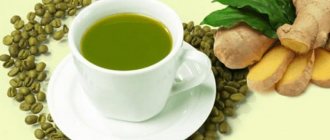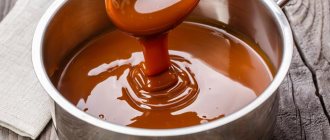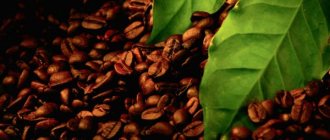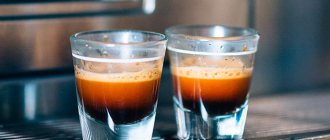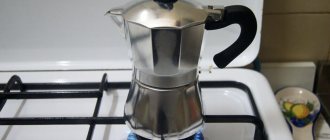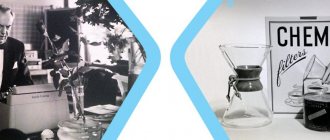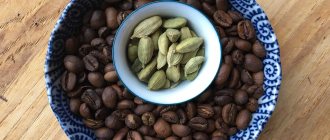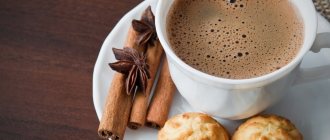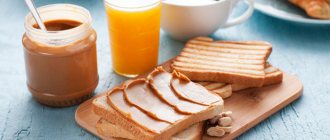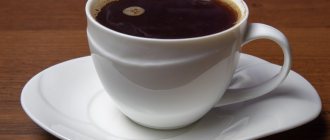Alternative brewing methods are a way to bring out the variety of flavors in coffee. Each method has its own characteristics, that's the beauty of them - try them all and find the one that suits you.
Equipment that will be useful to you for any cooking method:
- coffee grinder (if using bean coffee)
- scales
- teapot for brewing (preferably with a thin spout, this is the type of teapot that provides a uniform stream of water)
These tools will help you achieve a delicious, balanced cup, but if you want, you can do without them if you know a few tricks. For example, how to achieve the desired water temperature without a thermometer or measure the required amount of coffee using a teaspoon - we will analyze this further.
Coffee machine
Brewing coffee using this method occurs very quickly and requires minimal human involvement. The process is almost completely automated; you just need to fill the device with ingredients and press a button. The coffee machine itself grinds the beans, doses them in accordance with the selected program and passes boiling water under pressure through the resulting powder. The main method of preparing most machines is espresso, although some modern models can prepare cappuccino, Americano, latte and others, depending on their functionality and set of programs. But still, the number of recipes is limited and there is not much room for experimentation. Also, the disadvantages of these devices include cost, size and the fact that they are not particularly easy to clean. The rest is nothing but positives. The closest relative of a coffee machine is a coffee maker, a coffee maker that only performs the brewing function, and the process itself needs to be controlled. Some manufacturers deliberately call their coffee makers coffee machines to increase their price, so be careful when choosing.
French press
Equipment cost: from 200 rubles; Cooking time: 4 minutes; You can prepare many servings.
French press recipe
You almost certainly already have it in your house, maybe it's lying around in the back of your kitchen cabinet, or maybe you make tea in it. The simplest, easiest and most straightforward way is to pour it in, stir it, wait and press down. An undoubted plus is that in 4 minutes you can prepare coffee for the whole family, an undoubted minus is that the drink is dusty and should not be left in the French press; once prepared, immediately pour it into cups.
Hygiene for a French press is very simple, washing it is easy and convenient, you just need to dry its parts separately so as not to provoke the bacteria remaining in the particles on the mesh to ferment.
Drip coffee maker
Quite a convenient way to make a large amount of coffee for the whole family or office. It is easy to use and prepare, and has a high consumption of ground coffee. Cold water is poured into a specially designated container, then it is heated and rises through the tube to the filter, seeping through a layer of ground coffee and dripping into a glass coffee pot, which, as a rule, is located on a heated platform, so the drink remains hot for a long time. The coffee turns out to be less strong than espresso, with a less pronounced aroma, but richer in caffeine, which will help you cheer up in the morning. Over time, drip coffee makers have more and more additional functions for ease of preparation, including even a built-in coffee grinder, but the main task remains the preparation of filter coffee.
The effect of ground coffee on the human body, positive and negative aspects
An instant drink has a chemical composition that is far from a natural product, while ground coffee, which is not boiled, retains maximum natural properties that have an effect on the human body.
In addition to the caffeine itself, which is part of coffee, ground beans contain numerous natural oils and fats (lipids), organic acids, minerals and tannins, vitamins E, B and PP, as well as proteins and carbohydrates, which are beneficial for our health.
This composition has a positive effect on the body, which consists of the following points:
- increased vigor and body tone;
- dulling the feeling of hunger (therefore the drink is often used for weight loss);
- breakdown of fat cells;
- improved concentration and brain activity;
- the risk of some diseases is significantly reduced, for example, prostate cancer by 25%;
- slowing down cellular aging of the body;
- Improved mood and overall positive outlook on life due to stimulation of brain hormones.
With significant abuse of ground coffee, there may be negative consequences:
- development of insomnia;
- increased vascular pressure;
- risk of heart attack;
- migraine;
- problems with conceiving and bearing a child;
- leaching of calcium from the body;
- decreased hearing level.
We can say that the worst negative consequence is death from taking a lethal dose of caffeine, which is 10-15 grams. However, this amount of the substance is contained in 80-120 cups, so in practice it is almost impossible to die from your favorite drink, although it is clearly not worth abusing it.
Be sure to read: How to make coffee with ginseng at home
Chemex
It is a vessel similar to a laboratory flask tightly connected to a glass funnel. This design not only looks quite stylish, but also provides a sweet taste and perfectly reveals the aroma. Brewing coffee in a Chemex is quite simple. To do this, the flask is heated by wetting it with hot water. A special paper filter for Chemex is placed in the funnel, which is also wetted so that the edges can stick to the glass, thereby creating a barrier to air. Next, add medium or coarse coffee and add hot water (88-94 °C). First, a little to allow the grains to open themselves, after the water has drained, the rest of the volume is added. This is done slowly from the edges to the center of the funnel. This way the coffee is extracted best and brews evenly. To get the perfect Chemex coffee, you will need to experiment with grinding, water temperature, bean to water ratio, brewing time, and choose the type of coffee to suit your taste. But once you get the hang of it, you can repeat the characteristics of the cup you like over and over again.
Siphon (gabet)
Making coffee in a vacuum coffee maker is probably the most spectacular way. As with the Chemex, it's more like a chemical experience than a regular brew. It is more suitable for true coffee connoisseurs, since this method requires a lot of experience and effort. Making coffee this way every day is not an easy task, but to please guests or friends at a party with an excellent drink, it will do just fine, and even serve as a full-fledged show. The device consists of two flasks, a stand and an alcohol burner. When heated, water from the lower flask enters the upper flask, gradually wetting the filter with coffee. Then, under the influence of a vacuum, which is formed as the vessel with water is emptied, the finished drink begins to be drawn from the upper flask to the lower one. With this method, the coffee turns out rich and pure, as if it came from a chemical laboratory. According to many experts, this is one of the brightest, most delicious cooking options, if, of course, everything is done correctly, which, again, is quite difficult.
Turk, aka cezve
Cost of equipment: from 500 rubles; Cooking time: 5-6 minutes to cook and 5-6 minutes to settle; You can prepare one or two servings.
Turka recipe
You probably already have a Turk in your home and you probably don’t use it often, because to make delicious coffee in a Turk you need to know a few secrets. The first is an extremely fine grind, in which the coffee falls out of the grinder in clumps, rather than pouring out like sand. Unfortunately, the required grind is almost impossible to achieve with home coffee grinders. From the experience of our coffee shops, I can say that good grinding is provided by professional burr coffee grinders for espresso, the cost and size of which do not allow their use at home.
The best way to prepare Turka is in the sand, the heat evenly warms the coffee throughout the entire volume, the drink does not burn, and is prepared quickly enough. Sand takes a long time to heat up, this almost eliminates the possibility of cooking Turka on sand in the morning. There will definitely be difficulties with cooking a Turk on an induction stove - a copper Turk will ignore induction and will never heat up. You can deceive it by placing it on a steel frying pan that is on the stove. The main thing is not to drop this architectural invention in your sleep.
In stores you can find Turkish coffee pots for one, two or even five cups, but remember that a large-volume Turkish coffee pot will require a long time to warm up, which means the coffee will be over-extracted and begin to taste bitter. Therefore, I recommend cooking Turk in portions. One cup - one Turk. During cooking, the Turk requires your continuous attention, otherwise you will have to spend effort on cleaning.
The drink in the Turk turns out dense or, as coffee professionals say, dusty, but the method leaves room for experimentation - heat a piece of star anise, cloves or a drop of spices in the Turk before preparing coffee and your drink will sparkle with new colors.
Coffee in a cup
If you don’t have any special equipment for brewing coffee at hand, you can do it directly in the cup. Ground bean coffee is definitely better than instant coffee, which contains only 15% coffee itself, and the rest is chemicals. There are many interpretations of this method, but most of them boil down to pouring freshly ground coffee into a cup, adding water and letting it brew. The water can be either hot or cold, it all depends on the recipe. It is better to take a cup with thick walls. You can place the coffee in a cotton bag, as is done in South American countries. There are a lot of options and they all work! But this, of course, is not a great method; it is still better to use more advanced methods to please yourself with a cup of delicious, aromatic, balanced coffee every day.
YouTube tutorial videos and our coffee patrols.
Love that unites civilizations
Coffee is one of the few drinks whose love for it unites different peoples.
And his more important recipes are “born,” of course, in countries where feeding coffee trees is the basis for the well-being of the inhabitants.
The open or Brazilian method of making coffee is correctly regulated by documents and is used during cupping.
How to brew coffee correctly, according to professional tasters, in order to smell it more, recognize the “sourness” and determine the stability of the taste?
During cap-testing, the freshest coffee, roasted for less than 8-12 minutes, ground as for a French press, is used.
It is poured into a glass or clay cup with a volume of 200-260 ml, taking into account the proportion of 8.25 g (+/- 0.25 g) per 150 ml of water. The latter is crystal clear and transparent, its temperature is 92-94C. Pour in water in an even, narrow stream, covering the coffee powder moderately. Without covering, infuse the drink for 4 minutes. During this period of time, a crust appears on its surface - this is the thickening that rises. It is carefully “broken” with a spoon. Half of the grounds are removed from the surface of the coffee, the rest settles to the bottom. The drink is ready for tasting.
In a more “folk” version of the recipe, coarsely ground coffee beans are used. They are poured with hot (92C) water at the rate of 9 g per cup, and infused without covering. After 4 minutes, remove the film from the surface - and enjoy!
Cuban coffee is indescribably strong, very sweet and very hot. In its historical homeland, it is prepared using the consistency of beans from several dozen species of coffee trees grown only on Cuban soils. Due to weather conditions, Cuban coffee is very rich in caffeine. Cubans often drink it “with a cigar” - after all, this is a drink for real machos.
How to boil coffee in a cup Cuban style?
It is better to brew it in a faceted glass. To get the right strength, choose a strong roasted coffee consistency with the inclusion of Robusta or Latin American Arabica.
The order of action and proportions of ingredients are as follows:
- Pour 13 g of medium-ground grains into a glass.
- Stir in 20g cane sugar.
- Pour 200 ml of boiled and slightly cooled water.
- Leave for 4-5 minutes.
- Before use, add 5 tsp. Roma
When served, the drink should be very hot; it should be drunk in very small sips.
The charge of vivacity after it simply goes off scale.
Everything about this coffee is very, very good!
The lack of coffee production did not prevent the “birth” of very extravagant recipes in this country.
A distinctive feature of the “Polish” drink is that it is drunk together with grounds. To prevent coffee sediment from being so annoying, only very finely ground beans are used in production.
Because of its strength, this drink is considered “healthy” very conditionally. It is not recommended to infuse it for more than 2-3 minutes, because the extraction of caffeine, tannins and other “stimulating” components continues as long as you drink the drink, and ends in the digestive system.
What should be the grind, how much water and how many spoons of coffee will be needed to make it?
- Grind the coffee beans into powder, as for Turkish coffee.
- Boil and cool a little water - 60-100 ml.
- Warm up the mug (or cup).
- Pour 5-6g of ground coffee beans into it, i.e. 1 tsp with a slide.
- Pour in the prepared hot water.
- Stir until foam appears. Cover.
- After 2 minutes the drink is ready to drink.
There is another variation of strong “Polish” drink. Warsaw-style coffee is a drink with the most delicate foam and mild taste. The method of brewing it is similar to that described, but the strength is slightly “knocked down” by adding hot milk and sugar.
LiveInternetLiveInternet.
-Categories
- cooking (9940)
- 2nd courses (1923)
- baking (1920)
- salads, snacks (1715)
- winter preparations (1345)
- cakes (900)
- dessert (574)
- soups (386)
- drinks (382)
- jam (359)
- pancakes, pancakes (245)
- dough (186)
- multicooker (176)
- cabbage (166)
- bread (117)
- Easter (102)
- cutting dough (83)
- microwave (45)
- Salting lard (37)
- knitting (4720)
- hook (1557)
- knitting needles (1498)
- hats, scarves, mittens, snoods (662)
- IR (598)
- fooling around (445)
- slippers, socks (217)
- health (3805)
- dacha (2942)
- vegetable garden (172)
- flower garden (170)
- DIY decoration (43)
- diseases (42)
- fruiting plants (36)
- fertilizers (31)
- strawberry (23)
- raspberry (21)
- currant (20)
- natural farming (19)
- gooseberry (11)
- construction (7)
- sewing (1723)
- master class (1080)
- usefulness (1011)
- circuits (303)
- frames (18)
- thanks (13)
- simoron (874)
- beads (833)
- embroidery (760)
- this is interesting (404)
- spiritual practices (345)
- decor (314)
- drawing (279)
- music (177)
- sacred (156)
- stencils (134)
- paintings (119)
- video (86)
- tatting (57)
- flowers (23)
- soap making (22)
- all Gaudi (19)
- personal (5)
- macrame (1)
- (0)
-Music
,
-Search by diary
-Subscription by e-mail
-Regular readers
-Communities
-Statistics
How to boil delicious coffee directly in a cup: a general principle, but three different recipes.
How to boil delicious coffee directly in a cup: a general principle, but three different recipes
From time to time you don’t feel like making coffee, or you simply don’t have a coffee maker or a Turk at hand. Or, for example, we are at the dacha, where there is only a comfortable veranda, ground coffee, a cup and a kettle. What should I do? That's right, brew coffee directly into the cup. Now I will tell you my favorite method of doing this and share a couple of secrets. By the way, coffee brewed directly in a cup has its own unique, mild taste and a very pleasant smell. It won't look like coffee from a coffee maker, it will be different, try it.
What will be useful for you?
In fact, all the recipes are similar to each other, differing only in minor details, but the taste of the drink changes dramatically from these little things.
And in order to figure out how to properly boil coffee in a cup, first, you need to understand the non-tricky list of ingredients and tools that will be useful to you.
First, take a cup. A thick-walled porcelain cup is almost always useful. It warms up well and retains heat, so the coffee cools down more slowly. In general, clay and even glassware will do.
Coffee. Use freshly roasted beans to fully reveal the taste and aroma. The finest grind is often used, then the coffee particles settle to the bottom more quickly, and the drink comes out cleaner and richer. Some recipes require medium grinding, and when cupping only the coarsest grind coffee is used. In the absence of a coffee grinder, you can use the means at hand, so as not to depend at all on modern technology.
The water for brewing coffee should be hot, but under no circumstances use boiling water, it will simply kill the taste of the drink, leaving only an unpleasant and empty mess in the cup. Perfect temperature around 95°C.
Paper filters. Those who know how to brew coffee in a cup don't worry about coffee grounds. If everything is done correctly, then it simply settles to the bottom and does not interfere with your enjoyment. In general, an ordinary cardboard filter helps to quickly filter the drink and make it cleaner.
Sugar and spices for coffee at your discretion. Like filters, this item is optional, but spices will help make the taste truly unique.
General nuances for brewing coffee in a cup
First you need to pour boiling water over the cup and pour it over for almost a few minutes so that the cup warms up. Then the coffee stays hot longer and reveals its flavor characteristics better. Add 1–2 teaspoons of finely ground coffee per 100–150 g of water into a cup. Cover the cup with a saucer and let the drink sit for about 4 minutes. At the final stage of production, you can add spices, sugar, chocolate at your discretion, which can decorate the drink and give it more specialness.
Be sure to experiment with types of coffee, try different blends. Not all of them are mixed with spices, but each of them has its own unique taste and aromatic characteristics, which are fully revealed when brewed using such a simple and easy method.
A few common recipes
In fact, every nation, and especially in countries that are usually associated with coffee growing or coffee culture, has its own idea of how to brew ground coffee in a cup so that it turns out delicious. We will present several important, in our opinion, recipes.
Brazilian method, also open. This is the method used during cupping. To do this, you need coarsely ground coffee at the rate of 9 g per 100 ml of water. There is no need to cover the cup; the rising cap from the grounds holds the smell well, and after making it simply breaks with a spoon.
Warsaw method of coffee making. A more common method is to use finely ground coffee. The cup is covered with a saucer, but filtering the drink is not customary. In this case, it comes out stronger and more invigorating - the best option for every morning.
Cuban coffee. This drink is boiled in a glass, adding a little cane sugar, and medium grind coffee is chosen. Having mixed the ingredients well, you can pour hot water over the coffee. A sweet drink energizes you and helps you cheer up before work. You see, the recipes differ only in the degree of grinding of the coffee and the choice of utensils.
A few final words
We have already told you how to deliciously boil coffee in a cup. But, if the appearance of coffee grounds seems unsightly to you or it is simply unpleasant for you to drink coffee with grounds, no one forbids using filters. With them, the drink comes out lighter and more transparent, although not as strong. The filter can be replaced with special bags, in which tea is usually boiled.
If you couldn’t get a filter, then add a pinch of sugar during the manufacturing process, then the grounds will settle faster. Usually only coarsely ground coffee causes problems. A very small grind, on the contrary, by the time of consumption the coffee usually accumulates all over the day, and the brewing process goes a little faster.
Step-by-step instructions on how to brew coffee without a Turk.
At home, Turka is used in most cases to make coffee. It allows you to get a coffee drink of the highest quality, thanks to its own shape and the materials from which it is made. Coffee makers are used intensively along with cezves. Their final product comes out to be of completely good quality.
Quite often there are cases when novice coffee gourmets do not have either Turks or coffee makers in their arsenal and do not know what to use to brew an invigorating drink. Therefore, now we will tell you how to properly brew coffee without a Turk.
